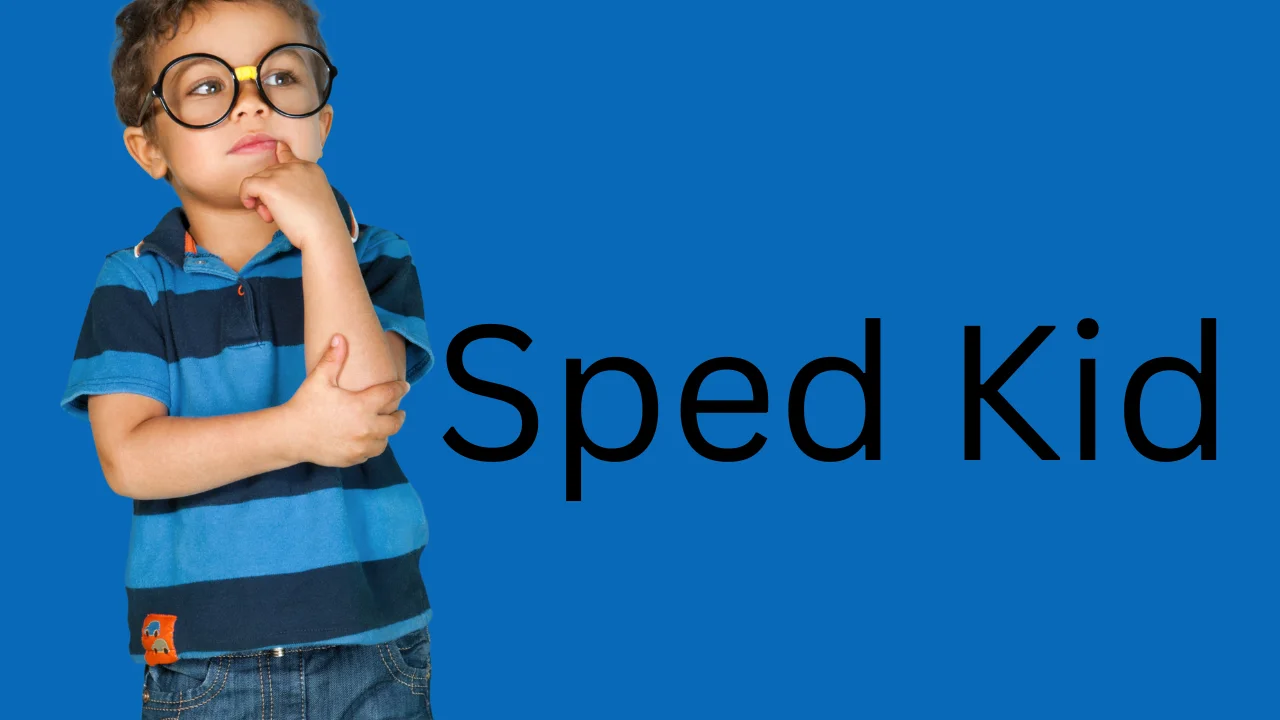Sped Kid Promoting Respect and Inclusivity in Special Education
Special education services address various needs of students with physical, cognitive, emotional, or developmental challenges. These programs are not one-size-fits-all; instead, they adapt to the specific needs of each student. For example, a student with a hearing impairment may require assistive technology, while another with autism might benefit from social skills training. The objective is to create an individualized approach, ensuring that every student reaches their full potential academically, socially, and emotionally.
Origin and Usage of “Sped Kid”
The term “sped kid” emerged as shorthand for students enrolled in special education programs. Special education, often abbreviated as “SpEd,” provides tailored instructional services to students with disabilities, ensuring they receive a Free Appropriate Public Education (FAPE) as mandated by the Individuals with Disabilities Education Act (IDEA). However, over time, “sped kid” has been used pejoratively to label and demean individuals, contributing to negative stereotypes and social exclusion.
History and Evolution of Special Education
The journey of special education has transformed significantly over the decades. Before the 1970s, many students with disabilities were excluded from public schools. The Education for All Handicapped Children Act of 1975 (later renamed IDEA) marked a turning point. This act mandated that schools provide free and appropriate education to all children, irrespective of their abilities. Over the years, the law expanded to include better accommodations, transition services for older students, and early intervention for infants and toddlers.
Understanding the Needs of Students Referred to as “Sped Kids”
Students receiving special education services often face misconceptions about their abilities. It’s important to understand that these students can excel when given the right tools and support. Needs can vary widely:
- Academic Support: Tailored instructions, resource rooms, and additional tutoring.
- Behavioral Interventions: Strategies to manage challenges, such as anxiety or impulsivity.
- Therapies: Speech, physical, or occupational therapies to address specific developmental areas.
Importance of Inclusion
Inclusion ensures that students with disabilities learn alongside their non-disabled peers whenever possible. Research highlights that inclusive classrooms enhance academic outcomes and foster mutual understanding among students. When children grow up together in a diverse environment, they become more empathetic and adaptable. For students receiving special education services, inclusion boosts confidence and social interaction skills, preparing them for real-world challenges.
Challenges Faced by Students with Special Needs
Despite advancements, many students referred to as kids encounter barriers in education. Stigma, lack of resources, and insufficient teacher training can hinder progress. Families often advocate for their children’s needs, but navigating the education system can be overwhelming. Schools must invest in professional development and community education to address these challenges effectively.
Role of Parents in Supporting Their Children
Parents of students receiving special education services play an active role in their child’s success. They collaborate with educators to develop and review IEPs and advocate for their child’s needs. Home support, such as consistent routines and reinforcement of skills learned at school, strengthens the child’s progress. Parents also help educate others about the importance of inclusive attitudes and practices.
Future of Special Education
With advancements in technology, special education is evolving rapidly. Tools like adaptive software, communication devices, and virtual reality are making learning more accessible and engaging. For example, apps that translate spoken words into text help students with hearing impairments, while immersive virtual experiences teach social cues to students with autism. These innovations promise a more equitable future for all learners.
Legal Protections Beyond IDEA
In addition to IDEA, other laws protect students with disabilities, such as Section 504 of the Rehabilitation Act and the Americans with Disabilities Act (ADA). Section 504 ensures students with disabilities have equal access to education and accommodations, even if they don’t qualify for special education under IDEA. The ADA extends protections to public and private settings, ensuring that individuals with disabilities have equal rights in all aspects of life, including employment and transportation.
Also Read: Hilton Embassy Suites Breakfast Hours and Offerings
Cultural Perceptions of Special Education
Cultural perceptions about students in special education vary globally. In some cultures, disabilities are embraced as part of diversity, while in others, stigma persists. Education systems worldwide are working to change these attitudes by promoting awareness and inclusion. Encouraging conversations about disabilities and celebrating success stories can help break down stereotypes and build supportive communities.
Legal Framework
The IDEA is a federal law that ensures services to children with disabilities across the United States. It governs how states and public agencies provide early intervention, special education, and related services. Under IDEA, students are entitled to:
- Free Appropriate Public Education (FAPE): Access to education tailored to their individual needs at no cost to the family.
- Individualized Education Program (IEP): A written plan developed for each public school child eligible for special education, outlining specific educational goals and the services the child will receive.
- Least Restrictive Environment (LRE): The requirement that students with disabilities be educated with their non-disabled peers to the greatest extent appropriate.
These provisions aim to protect the rights of students with disabilities and ensure they receive the necessary support to succeed academically.
Also Read: Guide to Roblox Rizz Tips, Tricks, and How to Master It
Key Elements of an Inclusive Education Environment
| Aspect | Actions Needed | Benefits |
|---|---|---|
| Language | Use respectful, person-first language, e.g., “student receiving special education services.” | Reduces stigma, promotes understanding, and builds a positive culture. |
| Resources | Provide teacher training, accessible facilities, and adaptive technologies. | Supports diverse learning needs and enhances educational outcomes. |
| Parental Involvement | Encourage collaboration between parents and educators for Individualized Education Programs (IEPs). | Ensures tailored support and better academic and social outcomes. |
| Peer Interaction | Foster empathy and teamwork among students through inclusive classroom activities. | Builds friendships, understanding, and a cohesive school community. |
| Legal Frameworks | Adhere to IDEA, Section 504, and ADA to protect student rights. | Ensures equitable education and access for all students. |
Special education services are not merely a legal requirement but a testament to society’s commitment to equality. By embracing inclusive practices and encouraging open dialogue about disabilities, communities can create environments where all students, regardless of their abilities, can thrive. Such efforts benefit not just students with special needs but also foster a generation of empathetic and socially responsible individuals. In the end, promoting respect and understanding ensures that no child is left behind in their journey toward success.
Importance of Language and Mindset
How we talk about students matters. Referring to someone as a “sped kid” can unintentionally reduce them to their educational classification, overlooking their individuality and potential. Instead, phrases like “a student receiving special education services” or “a student with unique learning needs” shift the focus to their humanity. Language shapes attitudes, and by choosing our words carefully, we can create a more compassionate society.
Role of Educators and Peers
Educators play a pivotal role in fostering an inclusive classroom environment. By implementing differentiated instruction and promoting empathy among students, teachers can create a supportive atmosphere that values diversity. Peers also contribute significantly; encouraging positive interactions and understanding can help reduce stigma and build a cohesive learning community.
Moving Beyond Labels
It’s essential to move beyond labels like “sped kid” and recognize each student’s unique strengths and challenges. By focusing on individual abilities and providing appropriate support, educators and peers can help all students thrive. Embracing diversity and promoting inclusivity benefits not only students with disabilities but enriches the educational experience for everyone.
Also Read: Gojo Happy Cheerful Powerhouse of Jujutsu Kaisen
Summary
The term “sped kid” has sparked conversations about language, inclusion, and respect in education. By understanding its origins and impact, we can better support students with disabilities. Special education is a vital component of the education system, ensuring that all learners have the opportunity to succeed. Moving forward, embracing inclusion, advancing technology, and promoting awareness will shape a brighter, more equitable future for all students.
Conclusion
Understanding the implications of terms like “sped kid” is crucial in promoting respect and inclusivity within educational settings. By using person-first language and focusing on individual strengths, we can create a supportive environment that empowers all students to succeed. Recognizing the importance of special education services and the legal frameworks that support them ensures that every student receives the education they deserve.
Additionally, fostering inclusivity extends beyond language—it involves building a culture of acceptance where diversity is celebrated, not stigmatized. Educators and peers play a key role in dismantling stereotypes and fostering empathy. Schools must provide adequate resources, including teacher training, accessible facilities, and adaptive technologies, to meet the diverse needs of students receiving special education services. Parents, too, are integral in this process, advocating for their children and collaborating with educators to ensure the best outcomes.
Also Read: Kikufuku Perfect Blend of Tradition and Modernity in Japanese Confectionery







